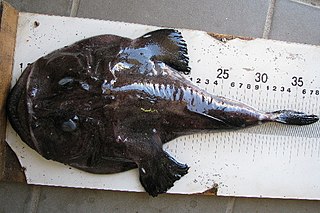
Goosefishes, sometimes called anglers or monkfishes, are a family, the Lophiidae, of marine ray-finned fishes belonging to the order Lophiiformes, the anglerfishes. These fishes are found in all the world's oceans except for the Antarctic Ocean.

Members of the genus Lophius, also sometimes called monkfish, fishing-frogs, frog-fish, and sea-devils, are various species of lophiid anglerfishes found in the Atlantic and Indian Oceans. Lophius is known as the "monk" or "monkfish" to the North Sea and North Atlantic fishermen, a name which also belongs to Squatina squatina, the angelshark, a type of shark. The North European species is Lophius piscatorius, and the Mediterranean species is Lophius budegassa.
Pogonoscorpius is a genus of marine ray-finned fish belonging to the family Scorpaenidae, the scorpionfishes. It is a monotypic genus, its ony species is Pogonoscorpius sechellensis which occurs in the western Indian Ocean in the seas around the Seychelles. It is a little known species and, as of 2018, only 2 specimens were known from the Seychelles. It may also occur in the Coral Sea and off Japan and it has been suggested that this taxon is a synonym of Rhinopias argoliba. Others treat it as a valid species and state that it is endemic to the western Indian Ocean.

Sladenia shaefersi is a species of fish in the family Lophiidae. It also commonly goes by the name of Shaefer's anglerfish. It was first discovered in the Caribbean Sea off the coast of Colombia and was described in 1976. It grows to 28 cm (11 in) standard length.

Bellator militaris, the horned sea robin, is a species of marine ray-finned fish belonging to the family Triglidae, the sea robins. This fish is found in the western Atlantic Ocean.

Lophiodes is a genus of marine ray-finned fishes belonging to the family Lophiidae, the goosefishes, monkfishes and anglers. It is one of four extant genera in the family Lophiidae. The fish in this genus are found in the Atlantic, Indian and Pacific Oceans.
Lophiomus is a monospecific genus of marine ray-finned fish belonging to the family, Lophiidae, the goose fishes, monkfishes or anglers. The only species in the genus is Lophiomus setigerus, the blackmouth angler, blackmouth goosefish, broadheaded angler or broadhead goosefish. This fish is found in the Indo-Pacific.

Zanclorhynchus is a genus of marine ray-finned fishes belonging to the family Congiopodidae, the pigfishes or horsefishes. These fishes are found in the Southern Ocean.

Ectreposebastes is a genus of marine ray-finned fish, belonging to the subfamily Setarchinae, the deep-sea bristly scorpionfishes, part of the family Scorpaenidae. The genus is found in the Atlantic, Indian and Pacific Oceans.

Bairdiella is a genus of marine ray-finned fishes belonging to the family Sciaenidae, the drums and croakers. These fishes are found in the western Atlantic and eastern Pacific Ocean.

Chaetodon gardineri, Gardiner's butterflyfish, is a species of marine ray-finned fish, a butterflyfish belonging to the family Chaetodontidae. It is native to the Indian Ocean.

Caruso brachysomus is an extinct species of ray-finned fish belonging to the family Lophiidae, the goosefishes, monkfishes and anglers, within the order Lophiiformes, the anglerfishes. It was described by Louis Agassiz in 1835 from the Monte Bolca locality. It became extinct during the middle Eocene.

Lophius budegassa, the blackbellied angler or blackbellied monkfish, is a species of marine ray-finned fish belonging to the family Lophiidae, the goosefishes, monkfishes and anglers. This species is found in the eastern Atlantic Ocean and the Mediterranean Sea.

Lophiodes beroe, the white goosefish or white anglerfish, is a species of marine ray-finned fish belonging to the family Lophiidae, the goosefishes, monkfishes or anglers. This species is found in deep waters in the western Atlantic Ocean.

The humpbacked scorpionfish is a species of venomous marine ray-finned fish belonging to the family Scorpaenidae, the scorpionfishes. This species is found in the western Indian Ocean.
Protosciaena is a small genus of marine ray-finned fishes belonging to the family Sciaenidae, the drums and croakers. These fishes are found in the Western Atlantic Ocean.

Lophius vomerinus, the devil anglerfish, Cape monk or Cape monkfish, is a species of marine ray-finned fish belonging to the family Lophiidae, the goosefishes, monkfishes or anglerfishes. This species is endemic to the waters of the southeastern Atlantic and southwestern Indian Oceans around Southern Africa.

Lophiodes mutilus, the smooth angler or smooth monkfish, is a species of marine ray-finned fish belonging to the family Lophiidae, the goosefishes, monkfishes and anglers. This species is found in the Indo-Pacific.

Sladenia gardineri, the Indian round angler, is a species of marine ray-finned fish belonging to the family Lophiidae, the goose fishes, monkfishes or anglers. This species is found in the Indo-Pacific.

The Celebes monkfish is a species of marine ray-finned fish belonging to the family Lophiidae, the goose fishes, monkfishes or anglers. This species is found in the Indo-Pacific.

















